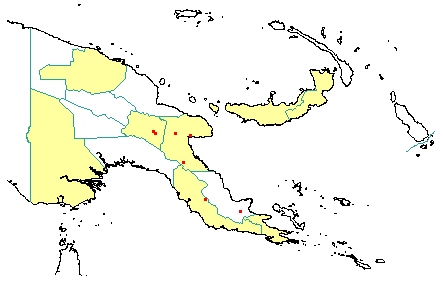
in PNGplants database
PNGTreesKey – Toona sureni (Blume) Merr. |
Barry Conn (NSW) & Kipiro Damas (LAE).
Guide to trees of Papua New Guinea
Copyright held by the authors, National Herbarium of New South Wales, and Papua New Guinea National Herbarium
An Interpretation of Rumphius's Herbarium Amboinense 305 (1917)
Other Literature: J. Havel, Forest Botany, Part 2 Botanical Taxonomy 130 (1975) Fig. 35-37.
Family: Meliaceae
Dicotyledon
Timber Group: Commercial hardwood Tradename: Red cedar
Field Characters: Large canopy tree (up to 50 m high); Bole markedly fluted (up to c. 60 cm diam.); straight (bole 20-30 m long); buttresses buttresses present (buttresses up to 2 m high) or buttresses absent; spines spines absent; aerial roots aerial roots absent; stilt roots stilt roots absent; Bark grey or greyish brown, rough, rarely scaly or flaky or coarsely fissured; Subrhytidome (under-bark) rarely red or brown; more than 25 mm thick (25-30 mm thick), 10.0 (c.); bark blaze consisting of one layer; faintly to non-aromatic; cinnamon-like or pleasant; outer blaze pale orange, rarely red, or brown, markings absent, fibrous; inner blaze pale orange, rarely red, or brown, markings absent, fibrous; bark exudate (sap) present, colourless, not readily flowing (spotty), colour not changing on exposure to air, not sticky; terminal buds not enclosed by leaves.
Indumentum: Complex hairs absent; stinging hairs absent; mature twig indumentum (hairs) present, hairs sparse.
Leaves: Leaves spaced along branches, spiral (leaves occurring singly at a node and arranged spirally up the branchlet), compound (a leaf made up from two or more leaflets); petiole present, not winged, attached to base of leaf blade, not swollen; leaves pinnate (unbranched with more than three leaflets); petiolule not swollen; rachis present, absent, absent; leaves without a terminal leaflet (the number of leaflets even - paripinnate), broadest below middle, leaflets opposite, symmetric; venation pinnate, secondary veins open, not prominent, but visible, intramarginal veins absent; leaves lower surface pale green, upper surface green, indumentum (hairs) present, indumentum (hairs) dense; absent; domatia present, scattered along midrib; stipules absent.
Flowers: Inflorescence terminal, flowers on a branched axis, cones absent; flowers unisexual, unisexual with male and female flowers on the same plant, stalked, flowers with many planes of symmetry, 4.0-5.0 mm long, diameter small (up to10 mm diam.); perianth present, with distinct sepals and petals whorls, inner perianth white; 5, free; stamens 5 (male flowers; 5 sterile anthers in female flowers), present, free of each other, free of the perianth; ovary superior, carpels joined (when more than one), locules 5; styles solitary, 1.
Fruits: Infrutescence arranged on branched axis, fruit 25.0 (c.) mm long, brown, not spiny, non-fleshy, simple, dehiscent, capsule (leathery); seeds many 100, much more than 10 mm long (11-20 mm long, rarely to 22 mm), winged (wings unequal), narrow (longer than wide), seed 1-10 mm diam. (4-4.8 mm diam.).
Distribution: East Sepik, Morobe, Eastern Highlands, Western, Central, Milne Bay & New Britain.
 | Botanical records in PNGplants database |